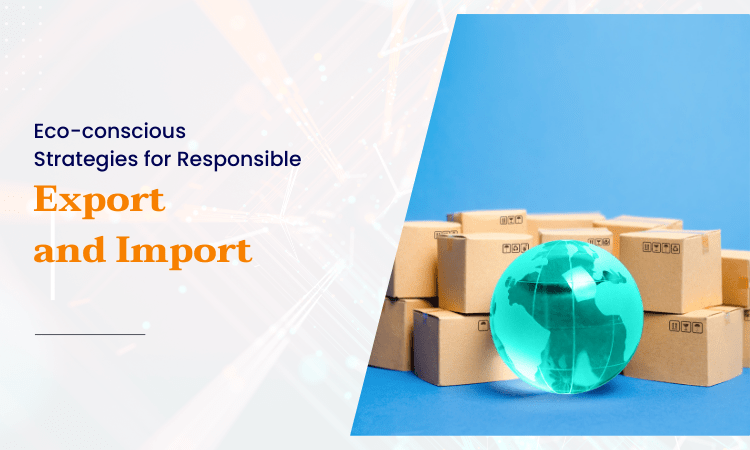Table of Contents
Introduction:
Do you dream of expanding your business beyond your borders, reaching new customers, and diversifying your income streams? Then unlocking the secrets of successful export and import strategies is your key to unlocking global success. This blog delves into the top tactics and actionable steps you need to master the art of international trade. From navigating logistics labyrinths to building cross-cultural bridges, we’ll equip you with the knowledge and tools to expand your reach, unlock hidden opportunities, and become a true global player. Buckle up, and let’s embark on your exciting journey into the world of international business!

1. From Local Hero to Global Giant: 5 Export Strategies to Scale Your Business:
Exporting your products or services can propel your business from local favorite to global giant, opening doors to unimaginable growth. But where do you start? Here are 5 export strategies to turn your local hero into a global powerhouse:
Market Research: Know Your Battlefield:
Don’t charge blindly into the international arena. Conduct thorough market research to identify countries with receptive audiences, analyze competitor strategies, and understand cultural nuances. Remember, “one size fits all” rarely applies in global trade.
Product Adaptation: Be a Cultural Chameleon:
Your winning product in your home market might need tweaks to resonate globally. Consider language translations, packaging adjustments, and even slight product modifications to cater to local preferences.
Logistics Labyrinth: Unraveling the Web:
Don’t underestimate the complexities of international shipping, customs regulations, and documentation. Partner with a reliable logistics provider or freight forwarder to navigate the labyrinth and ensure smooth transportation of your goods.
Digital Doorways: Open Your E-commerce Portal:
The internet is your passport to the world. Establish an e-commerce platform that caters to international audiences, accepting multiple currencies and offering localized payment options. Remember, global customers expect a seamless online experience.
Building Bridges: Partnering for Success:
Going it alone can be challenging. Consider collaborating with local distributors or partners who understand the market intricacies and can navigate cultural nuances better. This can save you time, resources, and open doors to valuable local networks.

2. Unlocking Hidden Gems: Top Strategies for Finding Profitable Import Opportunities:
Do you dream of sourcing unique products that turn heads and fill your shelves with profit? The world is brimming with hidden gems waiting to be discovered by enterprising importers. But how do you navigate the vast ocean of possibilities and unearth truly profitable opportunities? Here are your keys to unlocking import treasures:
Trendspotting Telescope:
Be an avid trend watcher. Follow industry publications, attend trade shows, and scour social media to identify emerging trends and unmet consumer needs. Look beyond your own market; sometimes, inspiration comes from unexpected corners of the globe.
Niche Nook Exploration:
Don’t chase the mainstream. Instead, delve into niche markets with passionate customer bases. Look for handcrafted products, local specialties, or sustainable alternatives that tap into specific consumer values. The smaller the niche, the less competition you’ll face.
Data Diving: Unearthing the Numbers:
Data is your friend. Utilize online platforms like trade databases and e-commerce marketplaces to discover trending products, identify potential suppliers, and assess market demand. Don’t underestimate the power of numbers to guide your decisions.
Barter & Beyond: Alternative Sourcing Strategies:
Think outside the box! Explore options like direct sourcing from artisans, attending international trade missions, or even participating in product sourcing competitions. These avenues can lead to unique discoveries and potentially lower costs.
Quality Quest: Beyond the Bargain:
Remember, the cheapest deal isn’t always the best. Prioritize quality, ethical sourcing, and a strong supplier relationship. Conduct thorough supplier evaluations, request samples, and negotiate based on quality, not just price.
Legal Labyrinth: Navigate with Confidence:
Don’t get lost in the legal maze. Familiarize yourself with import regulations, customs duties, and intellectual property laws for your target countries. Consulting with trade experts can save you headaches and ensure smooth import processes.
3. Culture Counts: Building Bridges with Effective Cross-Cultural Communication in Export-Import:
Imagine you’ve found the perfect product for your overseas market, your logistics are rock-solid, and your marketing shines. Yet, your sales remain stagnant. Why? The culprit could be a silent barrier: ineffective cross-cultural communication. In the intricate world of export-import, cultural understanding is your bridge to success. Here’s how to build it:
Beyond Words: Decode the Nonverbal:
Remember, communication goes beyond language. Learn about nonverbal cues like gestures, facial expressions, and silence in your target culture. A misjudged nod or an unintended power distance can derail negotiations.
Language Matters, But Nuances Do More:
Invest in professional translations, but remember, direct translations don’t always capture cultural nuances. Adapt your messaging to resonate with local cultural references, humor, and values.
Respectful Greetings, Paved Paths:
Research proper greetings, titles, and etiquette in your target culture. Showing respect from the outset fosters trust and lays the foundation for positive collaboration.
Active Listening: Bridge the Understanding Gap:
Don’t just hear; actively listen. Pay attention to both verbal and nonverbal cues, ask clarifying questions, and avoid interrupting. Demonstrating genuine interest builds rapport and paves the way for productive communication.
Patience is a Virtue, Especially Across Cultures:
Remember, business negotiations move at different paces in different cultures. Be patient, avoid rushing decisions, and respect the local decision-making process. Building trust takes time, and rushing can jeopardize a valuable partnership.
Embrace Diversity, Leverage Expertise:
Build a team with diverse cultural backgrounds and language skills. Leverage their insights to adapt your communication and marketing strategies to resonate with different cultural segments.
Cultural Sensitivity Training: Invest in Your Team:
Equip your team with cultural sensitivity training. Understanding cultural differences and avoiding stereotypes fosters more effective communication and stronger relationships with international partners.
4. Logistics Labyrinth Conquered: Streamlining Your Export and Import Operations for Success:
The world of international trade beckons, but the logistics labyrinth can seem daunting. Customs regulations, shipping complexities, and documentation hurdles can leave even seasoned businesses feeling lost. But fear not, intrepid exporter/importer! With the right strategies, you can transform the labyrinth into a smooth path to success. Here’s your map to conquering the logistics maze:
Know Your Terrain: Charting the Route:
Familiarize yourself with import/export regulations for your target countries. Understand customs procedures, required documentation, and any potential trade barriers. Knowledge is power, and it prevents costly delays.
Partner Up: Find Your Ariadne:
Don’t go it alone. Partner with a reliable logistics provider or freight forwarder with expertise in your target markets. Their experience and connections can navigate the complexities and ensure smooth transport of your goods.
Technology as Your Compass:
Leverage technology to streamline your operations. Utilize online platforms for customs clearance, real-time shipment tracking, and communication with partners. Embrace automation to manage documentation and reduce errors.
Inventory Optimization: Pack Light, Travel Fast:
Implement efficient inventory management practices. Analyze lead times, predict demand, and optimize stock levels to avoid unnecessary storage costs and delays. Remember, agility is key in international trade.
Communication is Key: No Secrets in the Labyrinth:
Maintain open communication with all stakeholders – suppliers, partners, and customers. Share timely updates, address concerns promptly, and anticipate potential issues. Transparency builds trust and prevents logistical hiccups.
Risk Management: Prepare for the Unexpected:
Be proactive in managing risks. Consider insurance for your shipments, understand potential delays due to weather or political instability, and have contingency plans in place. Minimize surprises and ensure continued operations even when storms hit.
Continuous Improvement: Always Onward:
Regularly evaluate your logistics processes. Analyze performance metrics, identify areas for improvement, and adapt your strategies to changing market conditions. Remember, the logistics landscape is dynamic, and so should your approach.
5. Compliance Crossroads: Navigating the Legal Landscape of International Trade:
The allure of international trade is undeniable – new markets, diverse customers, and amplified growth potential. Yet, stepping onto the global stage presents a daunting challenge: navigating the intricate legal landscape. Fear not, intrepid trader! With knowledge and careful planning, you can confidently traverse the compliance crossroads and ensure your business ventures thrive.
Charting Your Course: Know the Rules of the Game:
Ignorance is not bliss when it comes to international trade law. Familiarize yourself with relevant regulations, including export controls, import duties, and intellectual property rights. Each country has its own rules, so research thoroughly and tailor your approach accordingly.
Seek Expert Guidance: Don’t Go It Alone:
The legal landscape is complex, and navigating it solo can be risky. Partner with experienced trade lawyers or compliance consultants who understand the intricacies of international trade regulations. Their expertise can save you time, money, and potential legal headaches.
Embracing Transparency: Honesty is the Best Policy:
Maintain meticulous records of your transactions, including invoices, shipping documents, and product details. Transparency is key to demonstrating compliance and avoiding scrutiny from customs authorities.
Embracing Due Diligence: Know Your Partners:
Don’t just focus on your own compliance; assess your business partners as well. Conduct thorough due diligence to ensure they operate within legal frameworks and avoid association with sanctioned entities.
Staying Informed: The Knowledge Advantage:
The legal landscape is dynamic. Subscribe to industry updates, trade publications, and government announcements to stay informed about changes in regulations and potential risks. Knowledge empowers you to adapt your strategies and stay ahead of compliance challenges.
Building a Culture of Compliance:
Foster a culture of compliance within your organization. Train employees on relevant regulations, empower them to report potential issues, and create clear internal procedures for addressing compliance concerns.
Seeking Help When Needed: Don’t Fear, Ask for Support:
Remember, you’re not alone. Contact government agencies, trade associations, or your legal team if you encounter uncertainties or face potential compliance issues. Seeking help promptly can prevent escalations and minimize risks.

6. Financing Your Global Dreams: Creative Solutions for Export and Import Funding:
The international market beckons, your export-import dream is ready to take flight, but funding presents a formidable hurdle. Don’t let a tight budget limit your options! With a little creativity and resourcefulness, you can unlock the financial solutions needed to propel your global aspirations.
Beyond Traditional Loans: Exploring the Alternatives:
Don’t limit yourself to traditional bank loans. Consider alternative financing options like export credit agencies, which offer competitive rates and tailored solutions for international trade. Invoice financing can unlock immediate cash flow against receivables, while crowdfunding platforms can leverage the power of the crowd to support your venture.
Strategic Partnerships: Sharing the Burden, Doubling the Success:
Explore joint ventures or strategic partnerships with local companies in your target market. This can share financing burdens, provide valuable local expertise, and open doors to new distribution channels.
Grant Opportunities: Unearthing Hidden Gems:
Research government grants and support programs specifically designed to aid export-import businesses. Utilize resources like trade associations and chambers of commerce to identify relevant opportunities and navigate the application process.
Pre-Export Financing: Fueling Your Launchpad:
Don’t wait until your first international sale. Secure pre-export financing to cover production costs, raw materials, and other pre-shipment expenses. This can put you in a stronger position to compete and fulfill initial orders promptly.
Factoring & Forfaiting: Unlocking Receivables Potential:
Leverage factoring or forfeiting services to convert your export receivables into immediate cash. This can improve your cash flow and mitigate risks associated with international payments.
Crowdfunding: The Power of the Community:
Don’t underestimate the power of crowdfunding platforms. Pitch your export-import dream to a global audience and harness the collective support of individuals who believe in your vision. Be sure to craft a compelling story and offer attractive rewards to potential backers.
Leveraging Technology: Automation for Efficiency:
Utilize technology solutions to streamline your financial operations and reduce costs. Automated trade finance platforms can expedite transactions, optimize cash flow, and minimize administrative burdens.
Building Strong Relationships: Trust is Your Currency:
Foster strong relationships with international banks, financial institutions, and potential partners. Building trust and a solid track record can unlock access to better financing terms and favorable collaborations.
7. Digital Doorways: Leveraging E-commerce for Seamless Export and Import:
Forget physical borders and embrace the boundless opportunities of the digital world! E-commerce is revolutionizing international trade, opening doors for businesses of all sizes to tap into global markets with unprecedented ease. Here’s how to leverage e-commerce as your key to seamless export-import success:
Build Your Virtual Shopfront:
Establish an e-commerce website that caters to your target audience. Translate content, localize currencies and payment methods, and ensure a user-friendly experience across different devices. Remember, first impressions matter in the digital world.
Marketplace Magic:
Utilize global marketplaces like Amazon, Alibaba, or eBay to reach a wider audience and benefit from existing customer bases. Each platform has its strengths and nuances, so choose wisely based on your target market and product category.
Logistics Labyrinth Conquered:
Partner with e-commerce fulfillment providers who understand international shipping complexities. Choose a solution that offers competitive rates, efficient customs clearance, and real-time tracking to ensure smooth product delivery to your global customers.
Marketing Marvels: Speak Their Language:
Don’t just translate your marketing materials; adapt them to resonate with your target audience’s cultural preferences and online behavior. Utilize targeted social media campaigns, influencer marketing, and search engine optimization strategies tailored to each market.
Building Trust Bridges:
Customer reviews and ratings are your digital currency. Encourage satisfied customers to leave positive feedback and actively address any negative reviews to build trust and credibility in your global market.
Payment Gateways: Go Global with Secure Transactions:
Offer a variety of secure and popular international payment options like credit cards, digital wallets, and local payment methods. Partner with reliable payment processors to ensure smooth and secure transactions for your customers worldwide.
Data Drives Decisions:
Leverage e-commerce analytics to track customer behavior, identify best-selling products in different markets, and optimize your pricing and marketing strategies based on data insights. Remember, data is your guide to navigating the ever-evolving digital landscape.
Customer Service Without Borders:
Offer multilingual customer support through multiple channels like email, live chat, and phone. Respond promptly to inquiries and address concerns with empathy and cultural sensitivity. Remember, excellent customer service transcends borders and builds lasting relationships.

8. Sustainability in Action: Eco-conscious Strategies for Responsible Export and Import:
The world is waking up to the importance of sustainability, and responsible international trade is no exception. Consumers are increasingly demanding eco-conscious products and practices, making sustainability a strategic necessity, not just a moral imperative. Here’s how to integrate sustainability into your export-import strategies and position your business for success in the green economy:
Source Responsibly: Seek Eco-Champions:
Partner with suppliers who share your commitment to sustainability. Look for certifications like Fair Trade, Forest Stewardship Council (FSC), or Organic that demonstrate ethical and environmentally responsible practices.
Product Power: Choose Green Options:
Prioritize products made from recycled materials, with low environmental impact, and designed for durability and energy efficiency. Remember, sustainable products often resonate with eco-conscious consumers, boosting your brand image and sales.
Reduce, Reuse, Rethink Logistics:
Embrace sustainable logistics practices. Optimize packaging to minimize waste, explore environmentally friendly shipping options like ocean freight or electric vehicles, and offset carbon emissions from transportation activities. Every step counts in reducing your environmental footprint.
Transparency is Key: Share Your Green Story:
Don’t shy away from showcasing your sustainability efforts. Publish reports on your environmental initiatives, highlight green certifications, and educate consumers about your eco-conscious practices. Transparency fosters trust and attracts customers who align with your values.
Collaborate for Impact: Join the Green Movement:
Partner with other businesses, NGOs, and industry associations committed to sustainable trade. Participate in green trade initiatives, knowledge sharing, and advocacy efforts to amplify your impact and accelerate the transition to a sustainable global economy.
Innovation Drives Change:
Invest in innovation and research sustainable alternatives. Explore eco-friendly packaging materials, renewable energy sources for production, and carbon capture technologies to constantly improve your environmental performance. Staying ahead of the curve positions you as a leader in sustainable trade.
Continuous Improvement: The Green Journey Never Ends:
Remember, sustainability is a continuous journey, not a destination. Regularly assess your environmental impact, set ambitious goals for improvement, and adapt your strategies based on evolving technologies and best practices.

9. Partnerships for Progress: Collaborating with Local Expertise for Export and Import Success:
Venturing into the exciting, yet complex, world of international trade can feel daunting. Navigating unfamiliar cultures, regulations, and distribution networks can be a steep learning curve. But fear not, intrepid trader! The secret weapon in your arsenal? Local partnerships. Collaborating with experts who understand the intricacies of your target market can pave the way for smooth operations and accelerated success.
Bridging the Knowledge Gap:
Let local expertise fill the gaps. Partner with distributors, sales agents, or consultants who possess in-depth knowledge of your target market. They can guide you through cultural nuances, navigate bureaucratic hurdles, and tailor your marketing strategies for maximum impact.
Building Trust, Building Business:
Local partners can act as your cultural ambassadors, fostering trust and rapport with potential customers. Their understanding of local preferences, business etiquette, and communication styles can bridge the gap and open doors to valuable collaborations.
Network Powerhouse:
Leverage your partner’s existing network. Gain access to established distribution channels, local retailers, and industry connections, accelerating your market penetration and maximizing your reach within the target market.
Logistics Labyrinth Conquered:
Navigating import/export regulations and logistics complexities can be a headache. Local partners can handle customs clearance, documentation, and transportation with ease, ensuring smooth product delivery and minimizing costly delays.
Risk Mitigation: Sharing the Burden:
Entering a new market comes with inherent risks. Partnering with local experts allows you to share the risks and navigate potential challenges with their guidance and support. This mitigates potential pitfalls and ensures a more secure footing in your new market venture.
Cultural Chameleon: Adapt and Thrive:
Local partners can help you adapt your products, marketing messages, and overall brand image to resonate with the local culture. This cultural sensitivity is crucial for building authentic connections and achieving true market acceptance.
Learning & Growth: A Two-Way Street:
Treat your partnership as a collaborative learning experience. Gain valuable insights into the local market dynamics, consumer preferences, and evolving trends. This knowledge exchange empowers you to continuously adapt and refine your strategies for long-term success.

10. Future-Proofing Your Trade: Anticipating Trends and Adapting Your Export and Import Strategies:
The world of international trade is dynamic, ever-evolving, and rife with unforeseen challenges. While navigating the present complexities is crucial, true success lies in peering into the crystal ball and future-proofing your strategies. Here’s how to anticipate what’s coming and ensure your export-import business thrives in the ever-changing landscape:
Trendspotting Telescope: Seek the Signals:
Be an avid researcher, devouring industry reports, attending trade shows, and actively engaging with industry experts. Identify emerging trends in technology, consumer behavior, sustainability, and global politics. These signals pave the way for informed, proactive steps.
Technology Tsunami: Ride the Wave or Get Swept Away:
Embrace technological advancements like artificial intelligence, blockchain, and the Internet of Things (IoT). Utilize these tools to optimize logistics, personalize marketing, and enhance customer experiences. Remember, those who resist risk being left behind.
Sustainability Siren Song: Sing Along or Face the Music:
Sustainability is not a fad; it’s the future. Integrate eco-conscious practices into your supply chain, product development, and packaging. Consumers are increasingly conscious, and aligning with this trend is not just ethical, but strategically sound.
Geopolitical Gauntlet: Navigate the Shifting Landscape:
Stay informed about global political and economic shifts that may impact your target markets. Understand potential trade wars, currency fluctuations, and regional instabilities to anticipate challenges and adapt your strategies accordingly.
Agility is Key: Adapt and Thrive:
Don’t cling to rigid strategies. Cultivate a culture of agility within your organization, allowing you to quickly adapt to changing market demands, regulations, and consumer preferences. Be prepared to pivot, experiment, and embrace calculated risks.
Building a Resilient Supply Chain:
Don’t rely on single-source suppliers. Diversify your supply chain across different regions to mitigate risks associated with natural disasters, political instability, or trade disruptions. Building resilience reduces vulnerability and ensures business continuity.
Upskilling Your Workforce:
Equip your team with the skills needed to navigate the future of trade. Invest in training on digital tools, cultural sensitivity, and data analysis to ensure your workforce can adapt to evolving landscapes and contribute to sustainable success.
Embrace Continuous Learning:
The journey of future-proofing is never-ending. Stay curious, keep learning, and actively seek out new knowledge and perspectives. By fostering a culture of continuous learning, you ensure your business remains adaptable and innovative, ready to conquer whatever the future holds.
Conclusion:
The world awaits your business! By embracing the strategies explored in this blog, you’re well on your way to expanding your reach and thriving in the exciting realm of export-import. Remember, success hinges on careful planning, cultural sensitivity, and a commitment to continuous learning. Adapt to the dynamic landscape, embrace new opportunities, and overcome challenges with a strategic mindset. As you embark on this international journey, remember, the rewards are plentiful – not just in profit, but in cultural exchange, global impact, and the thrill of venturing into uncharted territories. So, step out with confidence, embrace the adventure, and watch your business blossom on the world stage!


